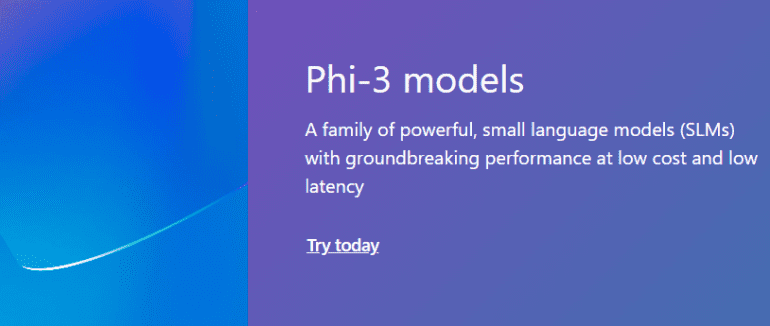- Microsoft introduces serverless fine-tuning for Phi-3-mini and Phi-3-medium models, simplifying customization without managing compute resources.
- Significant improvements in core quality, instruction-following, and structured output for Phi-3-mini models enhance performance at no extra cost.
- New model additions include OpenAI’s GPT-4o mini, Meta’s Llama 3.1 405B, and Mistral’s Large 2, providing broader options for AI applications.
- Phi-3 models are suited for cloud and edge environments, with new applications in educational tools like Khan Academy’s Khanmigo.
- Phi Silica is tailored for devices with Neural Processing Units (NPUs) in Copilot+ PCs, enhancing secure and reliable AI experiences.
- Azure AI’s serverless endpoint capability is now generally available, including for Phi-3-small, streamlining AI development.
- Community use cases include TD Bank Group exploring Cohere’s models and Atomicwork integrating Cohere Rerank to improve IT support.
Main AI News:
Microsoft has unveiled a series of substantial updates to its Azure AI platform, introducing new capabilities designed to bolster customization and scalability for AI applications. These enhancements include serverless fine-tuning for the Phi-3 model family, the launch of several new generative AI models, and an expanded selection of over 1,600 models available through Azure AI.
Serverless Fine-Tuning and Model Upgrades
One of the standout features of this update is the introduction of serverless fine-tuning for the Phi-3-mini and Phi-3-medium models. This innovation allows developers to tailor these models for specific cloud and edge applications without the need for dedicated compute resources. This streamlined approach is expected to simplify the customization process and accelerate the development of AI solutions.
The Phi-3-mini model has also undergone significant improvements. Enhancements in core quality, instruction-following, and structured output have been introduced, enabling developers to leverage a more effective model at no additional cost. These upgrades are particularly valuable for developers looking to build applications that require high-quality responses and consistent performance.
Expansion of Model Offerings
Microsoft’s Azure AI platform now includes the latest models from major AI developers. This month saw the addition of OpenAI’s GPT-4o mini, Meta’s Llama 3.1 405B, and Mistral’s Large 2 to Azure AI. These new models offer greater flexibility and choice for customers, supporting a wider range of AI applications and use cases.
- OpenAI’s GPT-4o mini: Known for its advanced generative capabilities, GPT-4o mini offers improved performance and cost-effectiveness, expanding the range of applications possible within Azure AI.
- Meta’s Llama 3.1 405B: This model enhances advanced synthetic data generation and distillation tasks. Its integration into Azure AI provides users with access to high-performing tools for complex data processing needs.
- Mistral’s Large 2: This model surpasses its predecessors in coding, reasoning, and agentic behavior, positioning itself as a competitive option among leading models in the field.
Unlocking Value Through Customization and Innovation
Microsoft’s Phi-3 family, including Phi-3-mini and Phi-3-medium, has been designed with a small compute footprint and compatibility with cloud and edge environments. These models are well-suited for fine-tuning to address specific business needs and improve the quality of responses. They offer an economical alternative to larger models without sacrificing performance.
Phi-3 models are now being used to address new use cases, such as educational tools. Microsoft’s collaboration with Khan Academy illustrates this potential. Khan Academy has utilized Azure OpenAI Service to develop Khanmigo for Teachers, an AI-powered assistant designed to support educators across 44 countries. Phi-3 is being explored to enhance math tutoring capabilities, with initial research indicating that it performs better than many other leading AI models in correcting mathematical errors.
In addition, Microsoft introduced Phi Silica, a variant designed specifically for devices with Neural Processing Units (NPUs) in Copilot+ PCs. Phi Silica builds on the Phi family’s capabilities and is tailored for secure and reliable AI experiences on Microsoft Windows.
Models-as-a-Service and Serverless Capabilities
Azure AI’s serverless endpoint capability, now generally available, simplifies AI development by allowing developers to focus on building applications without managing underlying infrastructure. Phi-3-small is available through this endpoint, offering ease of access and integration for developers. Additionally, Phi-3-vision, a multi-modal model optimized for chart and diagram understanding, will soon be available via a serverless endpoint, further enhancing the platform’s capabilities.
Community Engagement and Use Cases
Microsoft’s commitment to providing advanced AI solutions is evident in its collaborations with leading organizations. TD Bank Group has partnered with Cohere to explore its suite of large language models, including Cohere Rerank, to improve customer experiences. Atomicwork, a digital workplace platform, has integrated Cohere Rerank into its AI assistant, Atom AI, resulting in improved search accuracy and faster IT support.
Responsible AI Development
Microsoft remains dedicated to advancing AI technology responsibly. The Azure AI platform includes features such as prompt shields and protected material detection, which are now default in Azure OpenAI Service. These tools help ensure content safety and monitor model performance. Azure AI also employs HiddenLayer Model Scanner to detect cybersecurity vulnerabilities and other threats in third-party models before they are included in the model catalog.
Conclusion:
Microsoft’s recent updates to Azure AI underscore its commitment to innovation and support for developers. The introduction of serverless fine-tuning for Phi-3 models, the addition of cutting-edge generative AI models, and the expansion of the model catalog provide a robust framework for building and scaling AI applications. With enhancements in model performance, customization options, and safety features, Azure AI continues to lead in delivering sophisticated, scalable, and secure AI solutions for a diverse range of applications.

